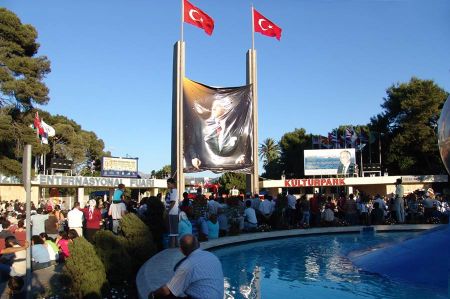Izmir Cultural History - Excavations at Tepekule Hill
- Written by Portal Editor
Recent excavations at Tepekule Hill near Bayraklı have shown that the Izmir region has been inhabited since around 3000 BC. The city's original name was "Smyrna," meaning "place of the holy mother."
Ancient Smyrna (Palaia Smyrna) is located about 4 km from what would later become Smyrna, modern Izmir, near the modern town of Bayraklı, which is now a district of Izmir. In ancient times, the town lay directly on the sea, but today it is several hundred meters away. Ancient Smyrna is the remains of a Greek urban settlement that was inhabited from around 1000 to around 300 BC; it was the predecessor of modern-day Izmir. The site was abandoned in 330 BC, and the inhabitants moved to the site of the present-day city of Izmir.
On the History of Ancient Smyrna

Around 600 BC, the city was destroyed and captured by the Lydian king Alyattes II. Traces of the conquest have been observed throughout the city during excavations. Most notably, the Temple of Athena was plundered and destroyed. The tumulus, a small settlement by the sea, was revitalized by those returning from the Trojan War; it continually expanded through relations with the Hittites, maritime trade, and the famous Temple of the Holy Mother.

During Byzantine times, the episcopal church was built on the ruins of the Temple of the Mother of Goddess. In the 7th century AD, the city was destroyed by Arab besiegers and conquered by Türkmenoğlu Caka Bey in 1081. In 1390, the area came under Ottoman rule and became an important trading centre. Izmir, occupied by the Greeks (Helenes) on May 15, 1919, was liberated in an unprecedented battle on September 9, 1922.
Excavations at In Bayraklı since the 1930s
A few traces of settlement date to the 3rd and 2nd millennium BC. The most important remains, however, date from the first millennium BC. The comparatively small city, with an area of approximately 6 to 7 hectares, had a massive city wall and a Temple of Athena. Excavations revealed only the remains of a platform of the Temple of Athena. The temple that originally stood on it was no longer preserved, apart from a few walls. Three main phases could be distinguished. The temple was built around 725 BC. In a second phase, dating from approximately 675 to 640 BC, a monumental pedestal was constructed. In a third phase (640 to 545 BC), a cella and a colonnade were built. Fragments of Aeolian column capitals and remains of mushroom-shaped capitals decorated with plant patterns were found. The capitals vary in detail, and it is difficult to reconstruct the columns, which were once about 10 m high.
This wall collapsed around 700 BC, perhaps as a result of an earthquake. Subsequently, the city appears to have been wall less for about a century. Around 600, a new wall was built, which was up to 15 m wide.
The last wall dates to the 4th century BC. Shortly thereafter, the city was abandoned.
Strabo's Historical Records
The most important archaeological work visible today in İzmir is the rectangular State Agora, measuring 120 x 80 cm, located in the Namazgah district. At the east and west ends of the agora are 17.5 m wide, two-story levels with double rows of columns. In the northern part of the agora is a two-story Byzantine Basilica. Partial ruins of the aqueducts can be seen in the city.
In ancient times, various temples and buildings were located around the Kadifekale. Strabo describes these as beautiful buildings with wide, columned portals that stood along the street. In the Eşrefpaşa district, the ruins of the ancient road can be seen in the park. The ruins of the stadium and theatre on the northwest slope of the Kadifekale have completely disappeared.
Please also read:
The Danube in Serbia – Experience it with the Camping Club Serbia
